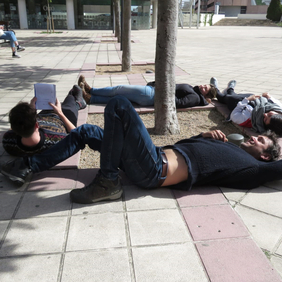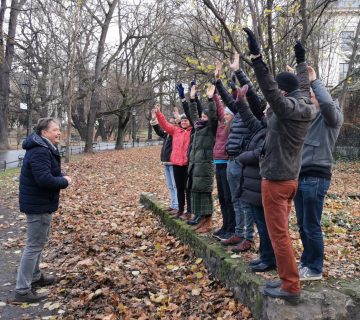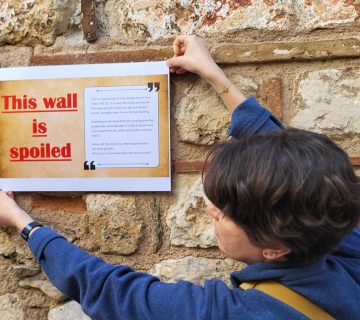
Taking up the circumference of the tree (Image: March Sarlat)
This Certified Interpretive Guide (CIG) course ran from 28 February to 1 March and then 6-8 March, and was led by Evarist March. The surroundings of the university campus where it was held are a mosaic of different natural and architectural heritage – both modern and ancient – offering many phenomena to form the basis of training tasks and interpretive talks, as well as giving life and a pleasant atmosphere to this unique place.
The course teaches the basics of interpretation through practical exercises that are boosted every time by the interaction between the participants. Moreover, the participants are also taught the following: being oneself, contributing through their own (job) experience; time notion and control; how to adapt to the various incidents of guiding; and the interpretive critique as a tool to improve.
A highly remarkable aspect of this course was the diversity of participants from so many nationalities (which included Spain, Brazil, Peru, Ecuador and Chile) as well as the generations and the different job positions (including tour guide to agricultural engineer). This diversity enriched the training for all of us due to the different points of view, knowledge and experiences coming together.
These are two examples of the interpretive talks developed by students.
“If you wanted to use this bush in the Middle Ages, you could end up dead by hanging“. This interpretive talk led us to discover the uniqueness of the broom shape of the shrub, Sarothamnus scoparius, transporting us from its magical medicinal uses to witch hunting, as the first documented femicide, this being related to the Day of the Working Woman that coincided with the same day of the interpretive talks’ exhibitions. The talk ended up with the delivery of a purple bracelet as everyone’s personal commitment to equality between women and men.
“The marble has an enormous multi-skilled talent“ consisted of interpretatively generating a consciousness in the audience of the relevance and essence of marble and its multi-functional forms and uses in their daily urban life.
In summary, the interpretive talks provided the participants with several emotions and senses by touching, smelling or interacting with the used resources or even hearing and profoundly feeling natural sounds, such as the wind.
As two of the participants, we would like to share our personal views on this course:
Elvira: “This training has given me a broad vision of guiding, giving me practical tools to start guiding and learn from my own mistakes as continuous improvement in this profession. I was also pleasantly surprised that they made us walk through the field of human emotions, personal growth, self-criticism and personal self-knowledge. It was great that the training was so practical as we could see ourselves as future guides.”
Marc: “The mutual understanding and the self-confidence that we gained or improved was really worthwhile, as well as the respect shown by the public every time, and the learning of so many techniques related to brightly explaining the natural and cultural heritage of the area.”
Elvira is an agricultural engineer specialised in medicinal and edible plants. She is also a therapist and performs therapeutic guides in nature. Now as an IE CIG she wants to guide natural, ancient architectural and intangible heritage. She collaborates with Piulet to edit heritage guide books. Elvira can be contacted at: elvira-rv@hotmail.com.
Marc Martín Benito is passionate about wildlife and nature and is about to finish studying a postgraduate course in Ecotourism and Nature Guide, having already got a degree in Tourism as well as other feats and certificates within this context. You can contact him at: marben4753@gmail.com.
To cite this article:
Ruiz, Elvira and Martin, Marc (2020) ‘A unique course interpreting natural heritage’. In Interpret Europe Newsletter 2-2020, 16-17.
Available online: https://www.interpret-europe.net/fileadmin/Documents/publications/Newsletters/Newsletter_summer_2020.pdf




